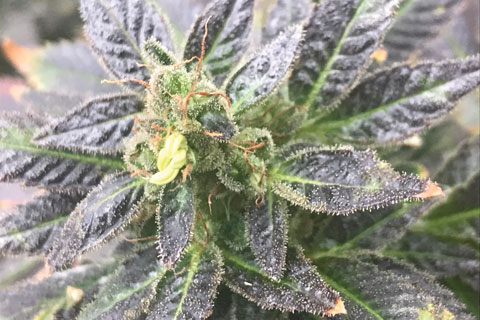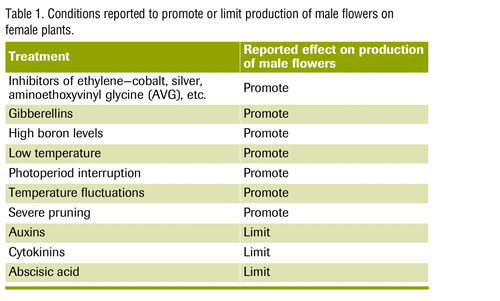6/1/2022
Let’s Talk About Sex
Dr. Brian Corr

In Greek mythology, Hermaphroditus was the son of the gods Hermes and Aphrodite. According to myth, a nymph named Salmacis was so attracted to him that the two merged to form one body, with both male and female attributes.
Figure 1. A cannabis inflorescence (“bud”) showing anthers emerging from male flowers surrounded by female flowers. The stigmas on the female flowers have turned brown, indicating they cannot be pollinated, so in this instance, the male flower is unlikely to result in seeds, although it’s unsightly.
In the plant world, hermaphrodites are very common by the botanical definition—having both male structures (anthers and pollen) and female structures (stigmas and ovaries) in the same flower. However, the term hermaphrodite (or “hermies”) has specific use in cannabis culture. To understand this requires understanding how cannabis plants are grown.
Female plants = More cannabinoids
Cannabis plants can be either monoecious or dioecious. A monoecious plant has male and female flowers on the same plant. In contrast, dioecious means some plants have only male flowers and other plants have only female flowers. Dioecious plants are beneficial for production of cannabis for cannabinoids since female cannabis plants produce more cannabinoids than male plants. In addition, without the presence of male plants, it’s possible to grow cannabis called “sinsemilla” (sometimes spelled “sensimilla”), derived from the Spanish phrase “sin semilla”—without seed. Inflorescences without seeds contain more cannabinoids than those with seeds.
For these reasons, most cannabis plants grown for medicinal or general adult use are female plants. However, under some circumstances, even female plants will produce a few male flowers. Male flowers may be few and scattered on the female plant, or at times can be numerous and in large clusters. The presence of male flowers can be catastrophic for cannabis production, since even a few male flowers can produce enough pollen to pollinate an entire crop, resulting in seeds, lower cannabinoid content and a crop of greatly reduced value.
Most often, cannabis producers grow female plants without any problems, and seldom or never see any male flowers. However, on occasion, male flowers start to appear. This is the phenomenon that’s called “hermaphrodism” in cannabis terminology. Some researchers refer to this as “intersex” plants or “sex reversal.” However, most cannabis growers use the term hermaphrodite.
Although male flowers on female plants are generally not desirable, in some cases it’s necessary to consciously cause male flowers to form on female plants. This is how “feminized” cannabis seed is produced. Feminized seed is seed harvested from female plants that have been pollinated with their own pollen. Plants grown from these seeds are (nearly) all female.
How does it happen?
Determining the conditions that cause hermaphrodism in cannabis has baffled researchers for over 100 years. For example, the Botanical Gazette published “Influence of Environment on Sexual Expression in Hemp” in 1921. The researcher reported the effects of the environment on “sex intergrades and sex reversals.” Plants grown in the winter were more prone to “reversal” than those in the summer. The researcher attributed this to lower levels of light and lower temperature than in the summer.
However, later the same researcher (and others) concluded daylength was the primary influence in causing sex reversal, with more reversals under short days than long days. But, as any cannabis grower knows, there are millions of cannabis plants grown under short days/long nights without production of hermaphrodites, so the length of day cannot be the sole factor.
 Over the last hundred years, researchers have investigated almost every possible environmental influence to determine the impact on development of hermaphrodites and have found many environmental conditions that appear to have an effect. However, there’s variability within studies and conflicting reports. This has led to the two things you can reliably expect to hear as explanations for hermaphrodites—“stress” and genetic predisposition.
Over the last hundred years, researchers have investigated almost every possible environmental influence to determine the impact on development of hermaphrodites and have found many environmental conditions that appear to have an effect. However, there’s variability within studies and conflicting reports. This has led to the two things you can reliably expect to hear as explanations for hermaphrodites—“stress” and genetic predisposition.
First, it’s not surprising there are genetic differences between different cultivars (strains) of cannabis in the likelihood to produce hermaphrodites. Cannabis growers know that if a particular cultivar routinely produces hermaphrodites it makes sense to replace that cultivar with another.
That “stress” causes production of hermaphrodites is a bit more problematic. Stress is difficult to define. Further, it’s not unusual for cannabis plants to experience stress without any hermaphrodites developing.
Taking action
What can a grower do if male flowers appear during production? Unfortunately, the only certain way to prevent pollination and resulting seed production is to carefully scout for all the male flowers and remove them before the pollen is shed. However, if harvest is scheduled in a week or so the male flowers can be ignored, since there won’t be sufficient time for pollen to be shed and seeds to develop.
Identifying male flowers on female plants is easy once you’re accustomed to looking for them, but they can be easily missed if you don’t look carefully. Female flowers have wispy, creamy-colored stigmas that look like two hairs. Male flowers do not have stigmas. Immature male flower buds are globe shaped. As they mature, anthers emerge. Anthers are sometimes called “bananas” because of their elongated shape. It’s the pollen shed by the anthers that causes all the trouble.
Prevention
How can hermaphrodites be prevented? With so many conflicting observations and research reports, it’s hard to make conclusive recommendations. A review of published reports and grower observations results in a long list of conditions that may promote or limit the production of male flowers on female plants (Table 1). However, some conditions seem more probable than others:
Photoperiod interruption—Light leaks from blackout cloth that doesn’t close properly are often blamed for hermaphrodites. Other related possible causes include the overuse of green “safe lights.” These lights are purported to not interrupt the dark cycle, but if overused may not be as “safe” as believed. It appears these lights may be acceptable for short periods of time at low light intensity, but can induce hermaphrodites on some cultivars if used for an extended time or with too great an intensity.
Wide temperature fluctuations—Cannabis can tolerate temperatures from freezing to above 100F (38C), although the temperature range for optimal growth is narrower. Many plants respond to a large positive difference between day and night temperature (DIF) by producing more gibberellins than plants grown with constant day and night temperatures. Since it’s known that gibberellins promote male flowers, a large increase in temperature in the day relative to the night temperature could favor male flowers.
Restriction of root growth—Since cytokinins are primarily produced in roots, and cytokinins are known to minimize formation of male flowers, observations suggest that damage to roots or restriction of root growth could favor production of hermaphrodites. Root growth restricted by cool temperatures in the root zone could be another cause.
Final thoughts
As mentioned, in addition to these three factors, there have been many studies done with many different environmental conditions to examine the effect on sex expression. Although plant nutrition has been implicated in some studies, there are as many studies showing high fertility favoring hermaphrodites as there are studies showing low fertility having the same effect. The evidence that fertility can promote or reduce development of hermaphrodites is very weak. Most studies have shown that fertilization doesn’t have an effect, either pro or con.
As more research is conducted, we’ll better understand the causes of hermaphrodites. But for now, a watchful eye and maintaining optimal growing conditions are the best ways to avoid problems. IG
Dr. Brian Corr is a consultant with over four decades of experience in the greenhouse industry. He’s advised legal cannabis producers for the last seven years.